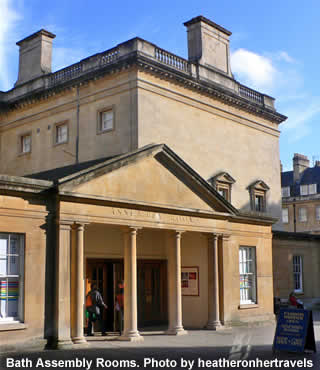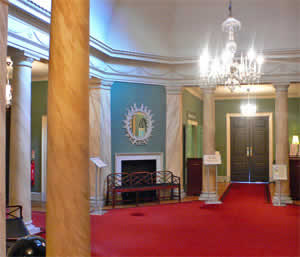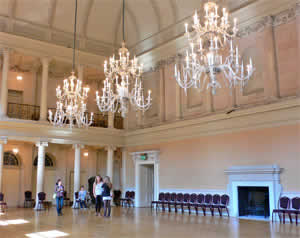Bath Assembly Rooms |
|
 |
|||
The social heart of Bath in the Georgian era |
||
Listen to this article |
||
When the Assembly Rooms were completed in 1771, they were described as "the most noble and elegant of any in the kingdom". The building became the most important social venue in the city. Men would come to play cards, and women to drink tea. Every so often, the rooms hosted a grand ball that would have the whole city talking. Anybody who's anybody would be there, all dressed up in the finest clothes money could buy. Mothers brought along their daughters, knowing that every eligible bachelor in Bath could be attending. Every young woman needed a suitable husband, and there was no better place to catch someone's eye. |
||
These were memorable scenes. They would have been discussed endlessly by the city's aristocrats, for days and weeks afterwards. One of the attendees in the early 19th century was the famous novelist, Jane Austen. The goings-on at the Assembly Rooms had such an effect on her that she wrote about them, in two of her novels. |
||
The building is now owned by the National Trust. Most of the time it's open to the public, free of charge. However, entry is not permitted when there's a private function in progress. This is one of Bath's premier events venues, and it's often used for dinners or weddings. The rooms can be hired either together, or individually, and each one has its own distinct character. |
||
 Inside the Assembly Rooms Photo heatheronhertravels |
||
The most striking of these is the Ball Room. At 30m long, it's the largest Georgian interior in the city. Lining the ceiling are 5 original crystal chandeliers, casting patterns of light across the walls. In the past, this would have held up to 1000 dignified guests dancing the night away. |
||
 The Ball Room Photo heatheronhertravels |
||
At a more reasonable hour of the day, the Georgians would have gathered on the other side of the building, in the Tea Room. The south-facing windows make this space bright and warm, while the rows of stone pillars add a degree of sophistication. |
||
Sandwiched between the Ball Room and the Tea Room is the Octagon. As you may be able to guess, this perfectly symmetrical room has 8 identically-sized walls. It's the most popular venue in the city for civil weddings. |
||
Next door to the Octagon is the last of the rooms-for-hire. This is the Card Room, which was added on to the main building in 1777. The Assembly Rooms had become a popular venue for games like whist and twenty-one, and people wanted a more private place to play. The space has since been converted into a bar and restaurant. |
||
The Georgian ladies and gentlemen that filled these four rooms would have been spectacularly attired. Their embroidered waistcoats and flowing dresses were something to behold. If you want to take a look, then you should head downstairs. On the lower ground floor of the Assembly Rooms is the Fashion Museum, which displays all the favourite styles of years gone by. The earliest pieces in the collection date from the early 1600s, but there are also examples of the very latest work by modern designers |
||
|
||
The Assembly Rooms are managed by the National Trust and are open daily, 10.30am to 4pm. Entry is FREE. Tel: 01225 477173 |
||
|
Pocket Britain is optimised for use on a smartphone or tablet with internet access. All content is subject to copyright. All reasonable methods have been used to ensure information supplied is accurate at the time of publication. However, it is advisable to check information before relying on it. Privacy Policy |